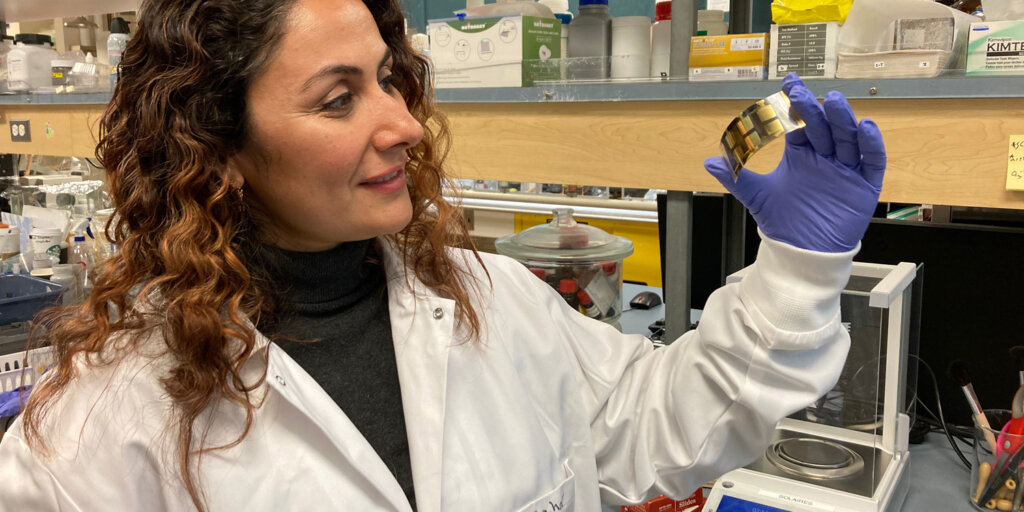Home » Solar power shake-up: How an obscure mineral is changing the clean energy game
Solar power shake-up: How an obscure mineral is changing the clean energy game

A crystal called perovskite is excellent at absorbing the sun’s rays. Several startups believe it could be the secret to creating solar panels that are thinner and more efficient.
Solar panels have become clean energy workhorses. They are the third-largest source of renewable electricity globally (after hydro and wind) and are growing fast. According to the International Energy Agency, solar power will account for two thirds of new clean energy capacity this year.
While solar panels are common sights on rooftops, they’re also appearing in more unusual places. Last year, a 7,000-square-foot solar wall — North America’s largest — was installed on an industrial building in Toronto’s Etobicoke suburb. Meanwhile, Solar Earth, a Vancouver-based company, claims it produces the world’s most robust solar panels, which can survive being walked on, driven over and even submerged in water for days. Its technology is being used to transform sidewalks, parking lots, roads and driveways into mini clean-power plants.
But it’s not just where solar panels are appearing that’s changing. How they generate electricity is also evolving. While most solar panels have been built using silicon, engineers are eyeing a crystalline material called perovskite that could transform how solar cells work.
Catching more rays
Most solar panels convert only about 15 to 20 percent of solar radiation into energy. The reasons for this are complex, but one is that the silicon they use is good at absorbing light in and around the visible spectrum, but much less so at infrared and ultraviolet wavelengths.
Toronto-based QD Solar has developed a new approach that it says could make solar panels more efficient. Instead of silicon, its technology uses two materials: perovskite and colloidal quantum dots. Perovskite absorbs ultraviolet and visible light but lets infrared pass through. These wavelengths are then absorbed by the colloidal quantum dots, which are tiny nanoscale semiconductor particles. When combined, they can harvest significantly more solar radiation than conventional silicon solar cells.
QD Solar produces large-format solar sheets that manufacturers can drop in on their standard solar modules, instead of placing individual silicon cells one at a time in existing panels. The process saves manufacturers time and money, while the solar sheets increase the efficiency of the panels by up to 40 percent.
Making a mark with solar ink
Solaires, a Victoria, B.C., startup is also tapping into the light-absorbing properties of perovskite. Solaires has created Solar Ink , which is made up of a distinct mixture of various chemicals and perovskite. The Ink can be used to create thin film-like solar cells that are transparent and so can be used in a wider range of locations than traditional panels. The company is looking at using its technology to power cellphones, laptops and smartwatches among other applications, although its formulation will need to be optimized for wavelengths of light available indoors.
“A lot of electronics around us, including all those IoT devices for smart homes, use batteries. We’re trying to replace batteries in the future with these small perovskite photovoltaic modules or to recharge the batteries with our modules,” says CEO Sahar Sam.
Solaires is also aiming to create solar cells that have a smaller environmental footprint. While existing solar panels produce zero-emission energy, the processes used to manufacture them have environmental impacts. With the International Renewable Energy Agency estimating that solar panel waste could reach 1.7 million tonnes in 2030 as early adopters replace their existing panels for newer models, this could become a significant issue.
Solaires claims its process to build perovskite solar cells is simpler and less energy-intensive than that used for silicon panels. The perovskite cells require fewer raw materials and can be manufactured in facilities at room temperature, whereas traditional solar panels need extreme heat to extract silicon from quartz and additional chemicals are added to remove impurities. Solaires also recently adjusted the formula of its Solar Ink to enable greener solvents to be used in its manufacturing process.
“If we’re looking for a cleaner world, it has to come from the process and end product. So that’s why we’re always looking for the best raw materials, processes and solutions that we can put together,” says Sam.
MaRS believes “innovation” means advancing Canadian technology for the benefit of all people. Join our mission.
Photography: Courtesy Solaires
MaRS Discovery District
https://www.marsdd.com/
MaRS is the world's largest urban innovation hub in Toronto that supports startups in the health, cleantech, fintech, and enterprise sectors. When MaRS opened in 2005 this concept of urban innovation was an untested theory. Today, it’s reshaping cities around the world. MaRS has been at the forefront of a wave of change that extends from Melbourne to Amsterdam and runs through San Francisco, London, Medellín, Los Angeles, Paris and New York. These global cities are now striving to create what we have in Toronto: a dense innovation district that co-locates universities, startups, corporates and investors. In this increasingly competitive landscape, scale matters more than ever – the best talent is attracted to the brightest innovation hotspots.


